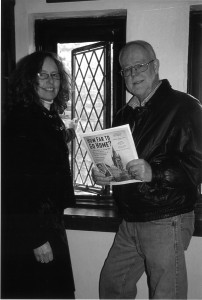For those looking for a love poem for February 14
“Here is the deepest secret nobody knows.
Here is the root of the root and the bud of the bud
And the sky of the sky of a tree called life;
Which grows higher than soul can hope or mind can hide.
And this is the wonder that’s keeping the stars apart.
I carry your heart. I carry it in my heart.”
by e. e. cummings
I am a rock. I am an island.
What would Hemingway think of Simon and Garfunkel’s song? The English words, “isolate” and “insular,” have the same root as “isola,” the Italian word for “island.”
Never be daunted, in public.
What would the Stoics have thought of Hemingway’s motto? I imagine that they would use only the first three words. Hemingway’s is more attainable, more a matter of pride than philosophy.
War is Over
By Eleanor Johnston and Wayne Fraser
The authorities of church and state in Jesus’ time fixated on establishing and maintaining power over the people, using rules and violence. The people surely felt no love for or trust in the Pharisees or the Romans. When Jesus spoke to the people of his society, they were drawn instinctively to him because he could teach and heal them. He loved them and this freed them from the top-down structures that impoverished them. His love was stronger than the rules of the Jewish religion or the laws of the Roman state.
Imagine that Jesus grew up in an Anglican family and worshipped regularly in an Anglican church somewhere in Niagara. He was a well-adjusted, gentle but strong child who dropped out of high school and took off to the poorest country in the world where he worked for an NGO. He kept in touch with his parents who worried about him but respected that he had to do what God called him to do.
One day, as the winter lessened its hold on the frozen land, he returned, walked into the office of the priest and introduced himself. The priest had heard of this young man and welcomed him. They sat down to tea and the first thing Jesus said was, “The cookies haven’t changed.”
They laughed and Jesus asked, “What are you and your people doing for God’s kingdom?”
After the priest had described the outreach program, Jesus asked, “How do you reach out to your parishioners?”
The priest started to feel uneasy. “I visit those who are sick or troubled in any way.” Jesus kept silent, and she continued, “Do you mean the care of their souls? You know, I try but they are so busy that they don’t have time for reading the Bible, studying it, praying together.” Her voice trailed off.
“What do they care about most?”
“Whether the server hands me the holy hardware in the right order.”
“What do you care about most?”
“The kids whose parents are abusive to fellow churchgoers, the street person who lives in the alley beside our church, the man who got rich illegally.”
“What’s the point of your Sunday service?”
“To worship God, to lift people’s hearts and minds and souls out of their everyday concerns, to inspire them to do God’s will through the coming week.”
“Does it work?”
The priest was overwhelmed. She put her head down on her desk, trying not to cry, wondering how this young man could so quickly get to the essence of her failure. “Only sometimes. Sometimes it feels like gang warfare.”
“What do you do about it?”
“They bully me. I’m afraid they’ll fire me.”
“Why don’t you want to be fired?”
The priest sat up and laughed. She started to feel a kind of peace she remembered from long ago.
Jesus said, “Let me tell you a story. A teacher walks into a classroom of screaming children and shouts, “Stop shouting!” The students ignore the teacher who says to herself, “These are badly behaved little brats. I’ll teach them who’s boss.” Using the school’s disciplinary system, she subdues the children and tries to teach the curriculum. The children spend the year irritating her without breaking any rules. They learn only that their hatred is stronger than the school’s rules.
A second teacher walks into a classroom of screaming children and starts speaking to them in a normal voice. She works for eye contact and smiles. Within minutes, there is silence and she keeps asking and answering questions, not repeating what they missed when they were noisy. She trusts that most of the children want to learn and to be liked. She models interest in the curriculum and respect in her treatment of every student. The children spend the year learning the curriculum, helping her and each other. They learn that love is stronger than rules.
“Now tell me, which teacher is of God?”
“The one who loved her students.”
“Now look at your church. Where is Emmanuel?”
“In you.” This was easy for the priest to say, but Jesus waited. Finally the priest had the courage to continue. “And in me.”
“And?”
“And in everyone in the parish.”
“Even in those who are chronically angry over customs?”
“Yes. And even ….” She paused.
Jesus nodded. “Yes. Even those whose belief in God is based on threats and power.”
“Okay, that’s a hard one for me.”
“And?”
“And in everyone in the world. And in every other species, and every other living thing.” The priest was exhilarated by hope.
Then the reality of her problems swamped her. “What can I do? I’m not a great teacher or a great healer. I can’t save the world or even ….”
“Remember me when you are about our Father’s business.”
“I know, the still small voice of calm. I know.”
“War is over.”
Reviews, anyone?
If you have read and enjoyed our book, Hemingway’s Island, please consider posting a review in lulu.com, amazon.com and barnesandnoble.com. We need to sell lots more copies in order to pay off the expenses of setting up this website and the bill for printing all kinds of copies that we ordered in a fit of enthusiasm.
About this Blog
At first we found it exhilarating, but then the posted responses were mostly repetitive spam while the verbal comments were appreciative and encouraging. The main problem with the posts is that most of them are either trying to sell something or seem to have been automatically generated by an automaton. So, we’d like to take another run at blogging, and hope to hear from readers of Hemingway’s Island. Perhaps we can get a conversation about Hemingway going.
We want to make sure this is clear. We will delete as spam any post that is generalized and any post that tries to sell something. One more pet peeve: if a post is so badly written that we have to struggle to understand its meaning, we will treat it as spam also.
Cover Comments
Recently, at Ridley College, St. Catharines, Bruce Croxon of CBC’s Dragon’s Den was photographed with Hilary Caters.
Caters Design Group created our book cover.
It all started with the Cuban flag colours that Hilary didn’t really like so she morphed them into sepia tones.
The front cover text includes:
The opening lines of Mary’s story: “If leaving the original manuscript in Cuba was Ernest’s rejection of me, keeping the carbon copy was my revenge.”
Mary’s last words in the book are from “Exile’s Letter” of Ernest’s mentor, Ezra Pound:
And if you ask how I regret that parting?
It is like the flowers falling at Spring’s end,
confused, whirled in a tangle.
What is the use of talking! And there is no end of talking —
There is no end of things in the heart.
The reader does not fully realize the importance of this poem, of Mary’s keeping a copy of her manuscript, and of the elements of hatred and love in her marriage with Hemingway, until the end of the book. The handwritten story (manu-script) is one of the highlighted words, as if written in a darker ink.
The three words beginning with “re” are “rejected,” “revenge” and “regret,” words that summarize Mary’s feelings as well as the mood and the central actions of the novel.
Now for the back cover:
Elizabeth and Hilary deserve credit for capturing the tone of the book and laying out the text. Larry Williamson took the picture that so vividly captures our relationship. It was our daughter, Alexa Fraser, who explained the magic of the picture. Can you see the heart in it?
Now for the spine:
What’s the title supposed to mean? Well, we played with many ideas for the book’s title and chose this one because it evokes the sea that Hemingway loved as well as Donne’s “Meditation XVII” that begins, “No man is an island.” The Italian word for island is “isolo” which suggests the isolation he experienced in his final years as he was tormented by mental and physical pains as well as by FBI harassment that compounded his sense of rejection and loneliness.
What’s Hearth Publications? When you self-publish a number of books, as I have, it’s good to have a collective name. This one comes from a blessing I received from a native woman who was also a nun: “May your love for Wayne be the hearth at which others can warm themselves.”
Cheers and Blessings, Eleanor
Public Reading for Hemingway’s Island
Wed, November 21, 7pm – 8pm
Centennial Branch, Fort Erie Public LIbrary
Meet Dr. Wayne Fraser and his wife Dr. Eleanor Johnston, and learn about Hemingway’s Island. Wayne and Eleanor have written and published a novel that explores Ernest Hemingway’s last days in Cuba. Researched by Wayne and written by Eleanor, “Hemingway’s Island is a novel packed with Hemingway lore for both aficionados and general readers.” Join Wayne and Eleanor for a reading and discussion of their novel.
$2 admission; copies of Hemingway’s Island will be available for sale and signing.
eBook version of Hemingway’s Island
Very happy to announce that Hemingway’s Island is now available in eBook format, available at the moment at Lulu.com: http://www.lulu.com/us/en/shop/eleanor-johnston-and-wayne-fraser/hemingways-island/ebook/product-20398723.html
Soon it will be available at iBookstore and Barnes and Noble NOOK bookstore and other retail channels. We’ll keep you posted.

